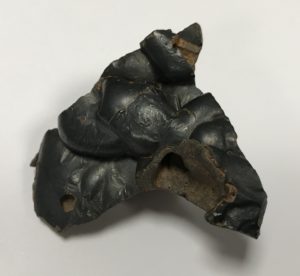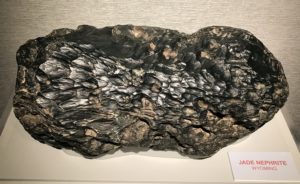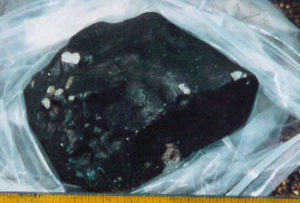Fall 2020
Meteor-wrong! It’s Slag!
By Sara Kurth



Have you been doing yard work while stuck at home and found a cool “rock”? Is it heavy, metallic looking and possibly magnetic? Did you just find a meteorite?! Probably not. What you may have found is something called “slag.”
Slag is the by-product of smelting, or the separation of a desired metal out of a raw ore. The most common slag found in the Chicago area is the result of steel production. The creation of steel requires iron. Native iron is rare in nature. Iron ore is derived from iron-rich minerals like hematite and magnetite. Nearly all of the iron ore deposits found on earth are older than 1.8 billion years. At that time, the earth’s oceans were saturated with dissolved iron and virtually no oxygen. Cyanobacteria, the first photosynthetic organisms, began releasing oxygen into the water. The oxygen and dissolved iron interacted, in essence, causing the oceans to rust, forming banded iron formations (BIFs). These BIFs alternate between iron-rich minerals like magnetite and hematite, and iron-poor minerals and shale. These bands are an indication of photosynthetic changes in the environment, thought to be a result of seasons(1).
Fast forward to the age of humans, the use of steel in construction dates back to 1800 B.C. in what is modern day Turkey(2). Prior to the 1850s, the process of making steel was very expensive and reserved only for small, expensive items like armor, swords, and knives. In 1857, Henry Bessemer developed the Bessemer Process, which more efficiently removed impurities from iron ore using oxidation processes(3). This resulted in the ability to mass-produce steel globally. The United States became a world leader in steel production from 1875 through 1970, with steel mills located throughout the country, mainly centered around the Great Lakes region including Pennsylvania, New York, Ohio, Illinois, Indiana, and Michigan. Chicago, ideally located next to Lake Michigan and the I&M canal, and its proximity to the Marquette Iron Range in Michigan, became one of the largest iron and steel producers in the world. By the end of the 19th Century, Chicago steel mills produced a million tons of steel a year(4)!
By the 1970s and ‘80s, however, a steel crisis hit the United States. Nearly a quarter of U.S. steel manufacturing equipment was inefficient, costing more in manhours than the cost for the steel itself. Foreign competition became a contributing factor to the decline in U.S. steel production. Today, the largest steel producer is ArcelorMittal with production facilities located around the world(5).
Although small amounts of steel are still produced in Gary, Indiana, just south of Chicago, the area is no longer the steel production hub of the past. The relics of this age can now be found in your very own backyard! It may not be the coveted meteorite you were hoping for, but slag tells us a story of Chicago’s past and that beauty is truly in the eye of the beholder.
References
1 King, H.M., “Iron Ore: What is Iron Ore, how does it form, and what is it used for,” 2020, Geoscience News and Information, https://geology.com/rocks/iron-ore.shtml, Retrieved September 5, 2020.
2 Akanuma, H. “The significance of the composition of excavated iron fragments taken from Stratum III at the site of Kamen-Kalehöyük, Turkey.” Anatolian Archaeological Studies. 14: 147-158, 2005, Tokyo.
3 Ponting, Clive, “World History, A New Perspective,” 2000, The University of Michigan.
4 Bensman, D. and M.R. Wilson, “Iron and Steel,” Encyclopedia of Chicago, 2005, Chicago Historical Society, http://www.encyclopedia.chicagohistory.org/pages/653.html, Retrieved September 5, 2020.
5 “Top steel-producing companies 2019,” World Steel Association, 2020, https://www.worldsteel.org/steel-by-topic/statistics/top-producers.html, Retrieved September 5, 2020.
On-going Fun!
Passport to Adventure
Visit participating Museum in Kane and DuPage Counties. Download your passport online by going to our website. Print out the Prize Page (3) and the Lizzadro Museum page (28). Visit sites to collect your stamps! Win a prize when your prize page is filled – good luck!
 Geocaching Scavenger Hunt
Geocaching Scavenger Hunt
Check out the new geocaching scavenger hunt for outdoor fun! Download the “Adventure Lab app from the App Store or Google Play, or visit the website. Once you’re logged on, check out the Museum Adventure Games
and start visiting sites! Each location has questions to be answered – win a prize at certain locations!
Passport to Adventure and Geocaching is sponsored by KDRMA (The Kane DuPage Regional Museum Association).





